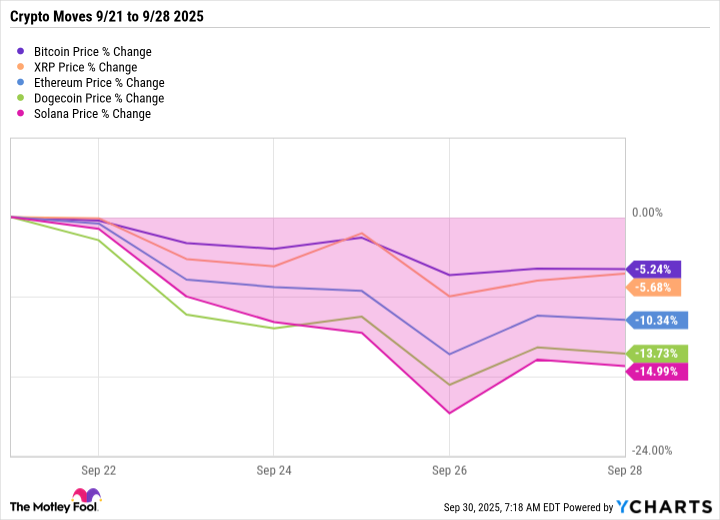The crypto sector took a collective tumble last week. It wasn't a completely harmonious drop, as stablecoins held firm (as intended) and outliers such as Zcash (ZEC 9.61%) posted big gains. But the overarching crypto trend was unmistakably bearish:
Bitcoin Price data by YCharts
In the seven-day Sunday-to-Sunday span from Sept. 21 to Sept. 28, Bitcoin (BTC 5.10%) and XRP (XRP 4.12%) dipped a little more than 5% each. Ethereum (ETH 4.95%) saw a deeper drop of roughly 10%, while more volatile names such as Dogecoin (DOGE 4.60%) and Solana (SOL 4.00%) fell even further.
Let's take a look at the factors that inspired these crypto price swings last week.

Image source: Getty Images.
1. Profit-taking reactions to a recent surge
Last week's crypto action needs a bit of additional context. The two weeks before this period were pretty bullish thanks to signs of stabilization in the American economy.
Encouraged by helpful trends in recent inflation reports and other macroeconomic data points, the Federal Reserve lowered interest rates for the first time since December 2024. As a result, risk-averse investors such as large financial institutions poured fresh cash into cryptocurrencies and crypto-based exchange-traded funds (ETFs). Mature cryptocurrencies (Bitcoin, Ethereum, and XRP, for example) posted roughly 5% gains and moved close to their all-time highs; Dogecoin and Solana enjoyed double-digit percentage gains.
That crypto-friendly period led up to a wave of profit taking last week. Some of the sales were also forced, as leveraged crypto investors had to settle margin calls on trades financed by borrowed funds. That's a risky business, folks.

CRYPTO: BTC
Key Data Points
2. ETF investors joined the profit-taking crowd
Investors who prefer spot-priced cryptocurrency ETFs over holding the cryptos directly are usually not big fans of high-risk, high-reward strategies.
This on-ramp to the crypto world is available to many accounts that simply can't touch Bitcoin or Ethereum directly -- large-scale institutional investors, personal retirement plans, and risk-dodging people who prefer an extra layer of regulatory protection. It's not surprising to see these groups take profits too, especially when the price peak was largely motivated by political and regulatory moves.
ETF owners can't make trades over the weekend, though. Therefore, the direct cryptocurrency drawdown on Sunday, Sept. 21, translated into a modest outflow of ETF funds on Monday, Sept. 22. The iShares Bitcoin Trust (IBIT 2.57%) saw a $38 million outflow that day, while the iShares Ethereum Trust (ETHA 4.14%) lost $15 million of customer funds.
These figures aren't huge, but that's still a sharp trend reversal from steady inflows in recent weeks.

CRYPTO: XRP
Key Data Points
3. Political pressure
And then there's the wonkish elephant in the room.
On Thursday, Sept. 25, more political pressure was piled on cryptocurrencies (and other investment markets). Congress threatened to close down government operations on Oct. 1, the Trump administration pledged to take military action in Gaza, and Federal Reserve chair Jerome Powell issued a stern warning that "there is no risk-free path" to a healthy economy.
That's the big dip you saw in the chart earlier. Crypto investors took Powell's warning seriously, and a $200 million outflow from the iShares Ethereum Trust made the earlier retreat look forgettable.
That's a bitter brew of profit taking and politics. I should point out that all five cryptocurrencies in the chart are up by at least 34% over the last year, more than doubling the S&P 500 (^GSPC 0.92%) stock market index's 15.5% gain over the same period.
Hence, crypto bears can still argue that the market remains overheated, while the bulls can treat this price dip as a buying opportunity. Either way, the events of last week probably didn't move many investors from one side to the other in that eternal clash.
